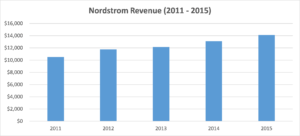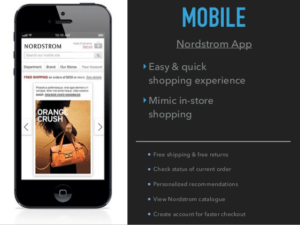Nordstrom: Integrating Digital with Retail

How Nordstrom is investing in digital technology to delight customers
For over 100 years, Nordstrom has been focused on providing the best shopping experience by empowering employees to provide an unmatched level of customer service. As a former Nordstrom retail employee, I have seen firsthand the emphasis the company places on understanding and anticipating consumer needs – from compiling a customer database detailing individual preferences to exclusive tailored shopping experiences. By focusing its technology investments on further enhancing the customer experience, Nordstrom has thus far been successful in implementing a digital strategy. With such a targeted goal, Nordstrom has able to selectively spend on the initiatives that align mostly closely with its business model, delight the customer with unique features and continuously improve its financial performance.
Understanding Customers
Nordstrom uses technology initiatives to empower employees with data to provide an even more personalized shopping experience. One of Nordstrom’s most helpful tools – its personal book software – is fully integrated into its point-of-sales system to equip employees with real-time shopper information. The online system contains a detailed profile of each customer combining in-depth collected data on customer preferences (like previous purchases and favorite brands) to employee notes (like personal information and shopping style).
Employees are rewarded for using this information to make the shopping experience more enjoyable. For example, employees can send personalized e-mails letting a customer know when their favorite brand is back in-stock or inviting them to an exclusive event. By having all of this knowledge at their fingertips, employee can provide the most helpful and efficient in-store experience. Similarly, mobile checkout makes the transition to the payment process seamless and ensures a consistent experience with a dedicated employee throughout the transaction [1].
Social Media
Nordstrom uses social media as another platform to connect with the customer. By engaging with apps like Pinterest and seeing what is trending online, Nordstrom is able to acquire a deeper understanding of customer preferences. Finally, Nordstrom links the in-store and online world by tagging items with red markers to indicate popular Pinterest items.
Secondly, an Engagement Labs study ranking how successful US retailers are at engaging customers put Nordstrom at the top of the list for both Facebook and Twitter. During this time, Nordstrom used these mobile platforms both to increase brand awareness and keep customers up to date on upcoming Black Friday sales [2].
Multichannel Integration
Nordstrom has also been increasing its online shopping focus. Since 2011, Nordstrom has tripled its online inventory at nordstrom.com as a savvy move to more effectively compete with rivals like Amazon. And, although it’s more difficult for outlets to sell online due to less predictable inventory, the Rack launched an e-commerce site in 2014 [3].
In addition to beefing up online offerings, Nordstrom has been focused on “omnichannel” retailing – incorporating all of its capabilities to provide a seamless experience whether in-store or online. Both nordstrom.com and the Nordstrom app are integrated with the inventory management system so that customers can easily find what they are looking for and have it delivered to the appropriate location quickly. Similarly, Nordstrom is using stores to handle online returns. In 2014, the company allowed shoppers to return purchases from both HauteLook (a flash site it purchased) and nordstromrack.com to its Rack stores, leading to 1 million more trips to a Rack store in that year. Once inside, customers are much more likely to continue shopping, thus increasing the likelihood of additional sales. Nordstrom has proven that, when done correctly, an “omnichannel” integration increases efficiency and provides retailers with a way to increase shopper traffic.
Conclusion
By focusing on improving its core capabilities, Nordstrom is successfully using digital innovations to better enhance the (already stellar) customer experience. The company has been selective in choosing technology that fits with their business model and, in turn, is providing customers’ with a truly integrated approach to shopping. From advanced in-store technology to a user friendly online presence, Nordstrom has proven that retailers can and should use digital innovations to connect with customers and grow their brand.
[1] https://hbr.org/2015/01/why-nordstroms-digital-strategy-works-and-yours-probably-doesnt






Great post, thanks for sharing! As a customer it is clear to me how Nordstrom digital efforts have contributed to an improved experience. On the value capture side, they have also invested in digital solutions that help lower their inventory costs. You may know already that Nordstrom recently bought a stake in DS Co., a supply chain startup that allows Nordstrom to do more “drop shipping,” therefore lowering the amount of inventory on their books and even getting the products to customers sooner. This only adds to their edge in a sector that is struggling to adapt to the e-commerce era.
Interesting post! Nordstrom’s brick and mortar stores stood out to me because of its superior in-person customer service and more pleasant shopping environment. However, those elements are not present on eCommerce, and Nordstrom’s website, offerings, shipping times, etc. look similar to those of its rivals. Do you have any thoughts on what features/elements Nordstrom could incorporate on its digital offerings to distinguish itself from competitors?